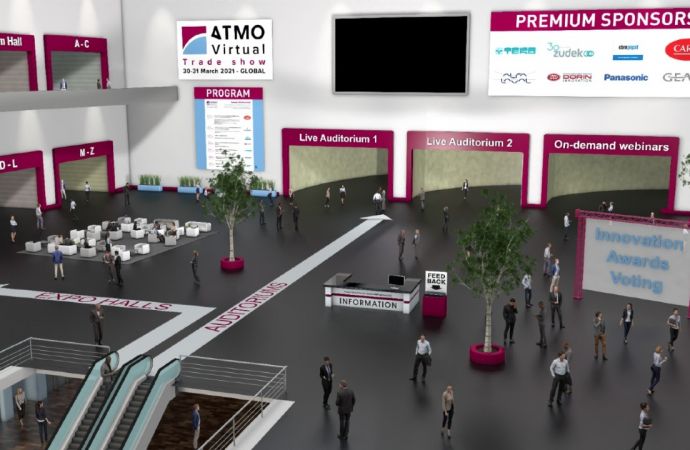Two dedicated workshop sessions on the first day of Atmosphere 2009 explored opportunities for hydrocarbons. This first article provides an overview of the first session which encompassed presentations by representatives from Earthcare Products, Danfoss and Unilever. Presentations now available.

Presenters during the first day of the international conference on natural refrigerants held in Brussels early this week, discussed the experiences with hydrocarbon technology in applications ranging from domestic through to commercial and industrial. All presentations reaffirmed the advantages of hydrocarbons in terms of energy efficiency and the viability of the natural refrigerant in a wide range of applications which could be further expanded should restrictive provisions such as the 150g hydrocarbon refrigerant charge limit were lifted.
Replacing R22 with Hydrocarbons: Practical Experience – Nicholas Cox, Earthcare Products
After presenting the advantages of using hydrocarbons in terms of energy efficiency, the presenter provided an overview of the product range available on the market until today, including ceiling cassette AC, ceiling mounted AC, ceiling concealed AC, wall mounted AC, chillers, including the largest chiller in the world installed at the Church house, Westminster with a cooling capacity employing 2x20 kg R290 and the latest models of R290 air cooled chillers, R290 ground source heat pumps, water cooled refrigeration cabinets.
He then moved on to discuss the regulatory barriers that hydrocarbons deployment faces today, including provisions of the Pressure Equipment Directive (PED) and standard EN378-2:2008. Regarding the PED he stressed the fact that although originally aiming to address pressure issues, it has been misused to address flammability issues which are normally addressed by other standards, and that there is therefore a need to review the Directive in order to make it easier to use flammable refrigerants. Cox then moved on to discuss the difficulties posed by standard EN378-2:2008 which effectively bans the siting of R290 equipment for human comfort below a height of 1.5 meters in the room and therefore rendering the deployment of R290 floor standing units, low level wall units, window units and split portables practically impossible. He noted however, that despite this restrictive standard, there is a big potential for hydrocarbons lying in high wall, ceiling, cassette and ducted units.
Hydrocarbons for Domestic Appliances – Jürgen Süss, Danfoss
Süss started off his presentation by describing R600a domestic refrigerated appliances as a “final refrigerant/application combination” for which short term technology changes are not expected and as such OEMs currently focus on continuous appliance enhancement and component suppliers concentrate on component development. To put things in perspective, he then provided a brief assessment of the development status of different refrigeration technologies to conclude that still today the traditional compression process offers the best value proposition for the HVAC&R industry.
Besides domestic applications, Süss discussed additional applications where hydrocarbons are relevant today such as bottle coolers, glass door merchandisers, ice cream freezers/chest freezers, commercial refrigerators and freezers and eventually any self-contained system with up to 150 g of refrigerant charge and industrial refrigeration applications (e.g. petrochemical industry).
The presentation finally provided suggestions as of how to push further the use of hydrocarbons through eliminating liability barriers, applying minimal refrigerant charge technologies, setting highest system efficiency standard based on hydrocarbon technology and enhancing safe and efficient operation by adding intelligence/electronics to systems.
Stakes and Opportunities for HC Refrigerant Use in Global Ice Cream Sales - René van Gerwen, Unilever
After referring to the four indicators that Uniliver has piloted to measure the impacts of its brands in terms of greenhouse gas emissions, waste, water and sustainable sourcing, van Gerwen explained that when applying this principle to ice cream –in which the company is a global market leader- the company has made the issue of tackling the global warming impact associated with the freezing cabinets a key priority, as it represents 20 to 40% of the total global warming impact of the ice cream supply chain.
After conducting initial technology and risk assessments of different technologies the company opted for using R290 cabinets for reasons of excellent environmental and energy performance, minor technology change and cost impact and the fact that this technology could be rolled-out fast. Subsequent testing validated the choice of using R290, with the results proving that hydrocarbon equipment is safe, as reliable as HFC and more importantly provides energy savings between 7 and 9% when compared to R404A products.
The presenter stressed the importance of training of service personnel in assuring a smooth roll out of R290 freezers. For the purpose, Uniliver worked with specialist training consultants to develop a detailed training package for service technicians, which now the local organisations ensure that their service personnel have pursued.
In terms of future challenges, van Gerwen referred to the roll-out of hydrocarbon equipment in the US, as well as obtaining solutions for bigger cabinets.
Replacing R22 with Hydrocarbons: Practical Experience – Nicholas Cox, Earthcare Products
After presenting the advantages of using hydrocarbons in terms of energy efficiency, the presenter provided an overview of the product range available on the market until today, including ceiling cassette AC, ceiling mounted AC, ceiling concealed AC, wall mounted AC, chillers, including the largest chiller in the world installed at the Church house, Westminster with a cooling capacity employing 2x20 kg R290 and the latest models of R290 air cooled chillers, R290 ground source heat pumps, water cooled refrigeration cabinets.
He then moved on to discuss the regulatory barriers that hydrocarbons deployment faces today, including provisions of the Pressure Equipment Directive (PED) and standard EN378-2:2008. Regarding the PED he stressed the fact that although originally aiming to address pressure issues, it has been misused to address flammability issues which are normally addressed by other standards, and that there is therefore a need to review the Directive in order to make it easier to use flammable refrigerants. Cox then moved on to discuss the difficulties posed by standard EN378-2:2008 which effectively bans the siting of R290 equipment for human comfort below a height of 1.5 meters in the room and therefore rendering the deployment of R290 floor standing units, low level wall units, window units and split portables practically impossible. He noted however, that despite this restrictive standard, there is a big potential for hydrocarbons lying in high wall, ceiling, cassette and ducted units.
Hydrocarbons for Domestic Appliances – Jürgen Süss, Danfoss
Süss started off his presentation by describing R600a domestic refrigerated appliances as a “final refrigerant/application combination” for which short term technology changes are not expected and as such OEMs currently focus on continuous appliance enhancement and component suppliers concentrate on component development. To put things in perspective, he then provided a brief assessment of the development status of different refrigeration technologies to conclude that still today the traditional compression process offers the best value proposition for the HVAC&R industry.
Besides domestic applications, Süss discussed additional applications where hydrocarbons are relevant today such as bottle coolers, glass door merchandisers, ice cream freezers/chest freezers, commercial refrigerators and freezers and eventually any self-contained system with up to 150 g of refrigerant charge and industrial refrigeration applications (e.g. petrochemical industry).
The presentation finally provided suggestions as of how to push further the use of hydrocarbons through eliminating liability barriers, applying minimal refrigerant charge technologies, setting highest system efficiency standard based on hydrocarbon technology and enhancing safe and efficient operation by adding intelligence/electronics to systems.
Stakes and Opportunities for HC Refrigerant Use in Global Ice Cream Sales - René van Gerwen, Unilever
After referring to the four indicators that Uniliver has piloted to measure the impacts of its brands in terms of greenhouse gas emissions, waste, water and sustainable sourcing, van Gerwen explained that when applying this principle to ice cream –in which the company is a global market leader- the company has made the issue of tackling the global warming impact associated with the freezing cabinets a key priority, as it represents 20 to 40% of the total global warming impact of the ice cream supply chain.
After conducting initial technology and risk assessments of different technologies the company opted for using R290 cabinets for reasons of excellent environmental and energy performance, minor technology change and cost impact and the fact that this technology could be rolled-out fast. Subsequent testing validated the choice of using R290, with the results proving that hydrocarbon equipment is safe, as reliable as HFC and more importantly provides energy savings between 7 and 9% when compared to R404A products.
The presenter stressed the importance of training of service personnel in assuring a smooth roll out of R290 freezers. For the purpose, Uniliver worked with specialist training consultants to develop a detailed training package for service technicians, which now the local organisations ensure that their service personnel have pursued.
In terms of future challenges, van Gerwen referred to the roll-out of hydrocarbon equipment in the US, as well as obtaining solutions for bigger cabinets.
MORE INFORMATION
Related stories




